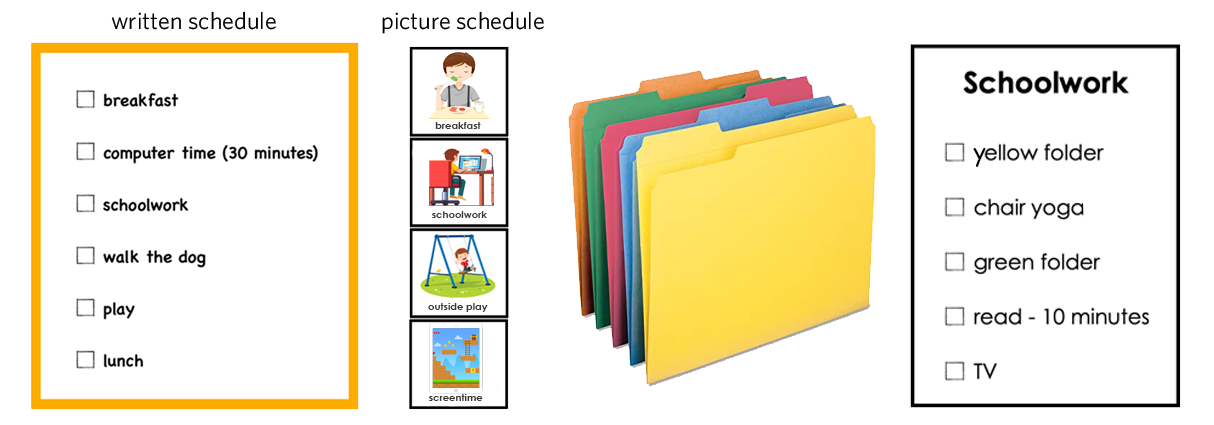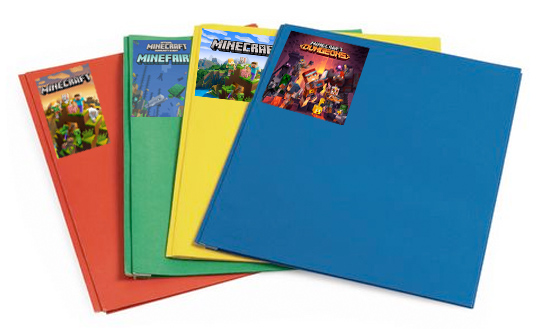TEACCH Tip#13 – Completing Schoolwork or Other Activities Independently at Home *updated*
With remote learning, many parents of school-aged children are tasked with teaching their children at home. Whether the individual is participating in a virtual classroom or completing work that has been sent home, learning and completing schoolwork from home can be challenging. For individuals with autism, it is even more challenging given the difficulty many children have with changes in routine. It is difficult to adjust to doing schoolwork at home when you are used to doing academics with a certain teacher, in a certain classroom, with certain materials. Your child might be thinking, “This is home. I don’t do this here!”
It helps to visually show the individual what to expect during the day and break down the day into chunks. Start by visually showing your child a visual schedule to indicate what time(s) during the day are for schoolwork.
If calling it “school” is upsetting for your child, try “Home School,” “Work with Dad,” or come up with another name. You can be creative and invent an exciting name!

Use a written or pictured list to show your child what he or she will be doing during “schoolwork” This might be a list of subjects (math, reading, science), a stack of worksheets, or colored folders with work to be completed inside.
Include the items to complete and also indicate what will happen immediately following work times. Knowing what will happen when the schoolwork is finished can increase engagement and reduce anxiety. Sometimes making the final activity something fun (such as watching TV) can increase motivation or the final activity might simply be the next activity in their day (such as time to read, have a snack, wash the dishes, etc. )
Teaching Tips:
- Designating a work or activity space can help clarify that this is work time. Since the goal is to help the individual focus and engage in meaningful activities on their own, ideally this area should have limited visual distractions and noise. The space might be different from where the individual typically works/interacts with others or completes other types of activities. If the space is used for other activities, you might create a cue that clarifies the areas is for working alone such as a colored placemat or a small sign that says “on my own” or the individual’s photo/name. Organize the workspace so that the individual can easily see and retrieve the assignment materials. Consider having a container with the items necessary to complete the assignments such as pens, pencils, highlighters, scissors, glue, etc.

- Consider separating worksheets or assignments into folders, sections of a notebook, bins, or shelves. These can be color-coded or labeled with favorite characters or themes (animals/sports) to increase engagement. If appropriate, include the individual in the development of the organizational system to increase their motivation to use the system.
- Clearly define a finished location for the completed work or activity. The work might go back into the folder or notebook or maybe it is placed into a “finished box” or on a designated shelf/drawer. Some students find it helpful to use a two-pocket folder with work to be completed on the left and then the child moves the completed work to the pocket on the right.
- Ease in! Remember, that completing schoolwork from home can be a big adjustment for everyone and that balance is important. If math is particularly challenging for your child, try starting with a subject that is an interest and strength for your child or provide a calming activity before doing math.
Helpful Hints:
- In order for the individual to work/engage in an activity independently, ensure that the individual understands the activities or academic materials.
- It is okay to have the individual complete half of a worksheet at one time – use a highlighter to show which problems to complete or post-it notes to cover up work that will be completed at a later time.
- When possible, give your child some choice about what sequence he/she wants to complete the tasks/assignments. Opportunities to choose and that sense of control can increase engagement!
- Some individuals might need a routine for having an adult check his/her work. You might write this at the end of the list, “Ask Mom to check work” or a card that says “Show mom”. This routine will ensure that the individual completes all work thoroughly and correctly before moving on to other activities.
